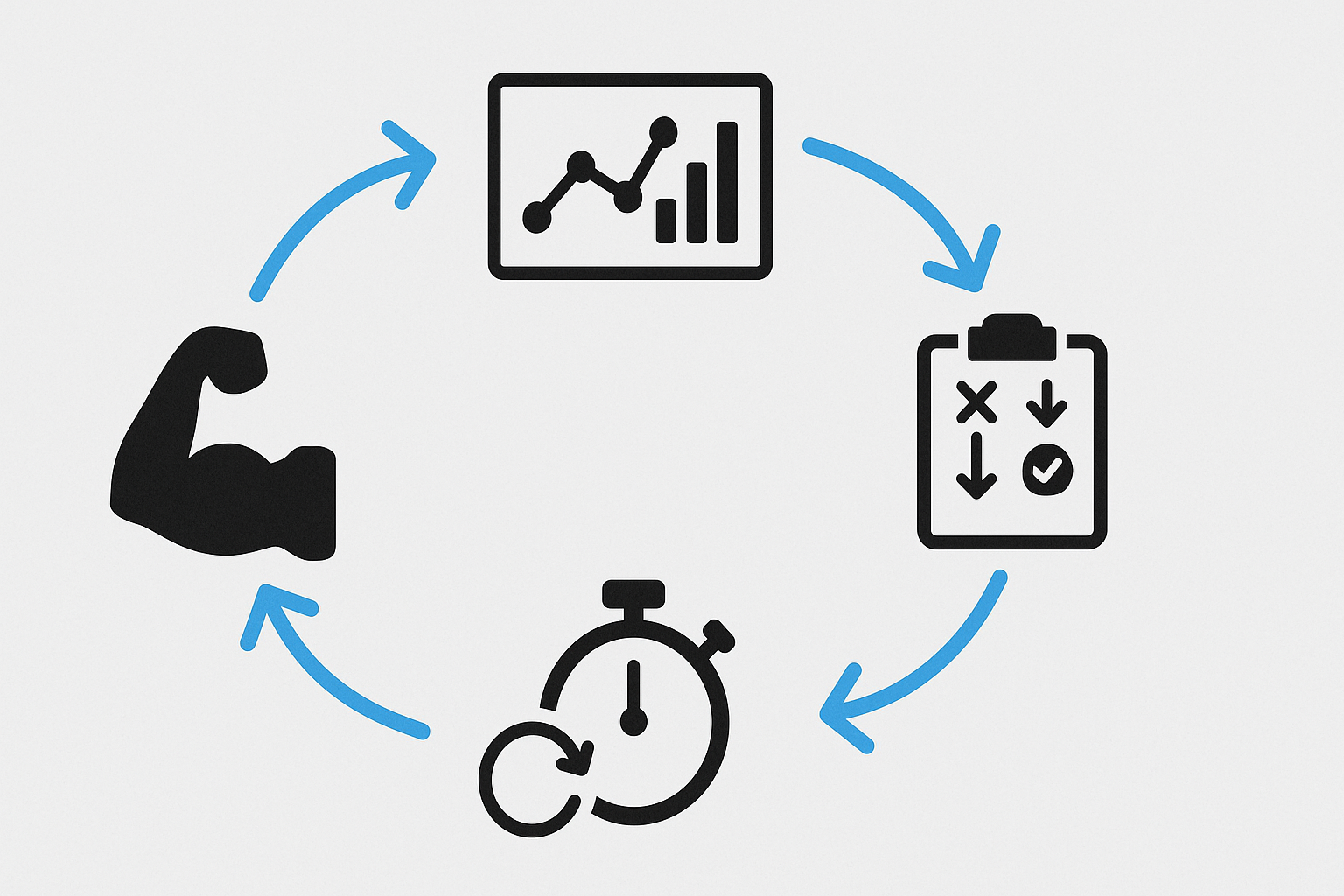Maximizing Results with a Smart Exercise Calendar
An intelligently constructed exercise calendar provides more than just structure; it acts as a strategic map that allows you to visualize and optimize your training flow. Unlike random training sessions, a well-orchestrated calendar allows you to anticipate key training milestones, manage fatigue, and ensure a balance between stress and recovery. As you follow your weekly rhythm, the calendar should highlight intensity waves—where volume or load peaks and then dips for recovery. This undulation prevents central nervous system burnout and overuse injuries while maintaining performance momentum.
One often underestimated advantage of a calendar is its ability to reduce decision fatigue. When you know exactly what your workout entails each day, mental energy is conserved for execution. A clear plan means no time wasted debating exercises or second-guessing volume. Your focus remains on performing with precision. Over time, this leads to more effective sessions and better cumulative adaptations. Integrating this level of clarity into your routine via an exercise plan template enhances training efficiency and ensures you meet progression targets.
A smart calendar also integrates lifestyle variables that influence training. Work deadlines, family commitments, and social obligations all compete for time and energy. Adjusting your calendar weekly—while still maintaining your overall training goals—helps preserve consistency. For instance, if a high-intensity day falls on a particularly stressful workday, your calendar should allow for intelligent shuffling without derailing long-term goals. This adaptability is key to sustaining a lifelong fitness journey.
Additionally, including built-in checkpoints—such as test weeks or performance evaluations—transforms your calendar into a dynamic tool of reflection and adjustment. These checkpoints allow you to assess whether your current trajectory is leading to meaningful progress. Logging these events in your workout spreadsheet enables data comparison over time, helping to uncover training correlations and better understand your body’s response to various stimuli.
The bottom line is that a smart exercise calendar is both structured and responsive. It balances discipline with flexibility, enabling you to push when conditions are optimal and to pull back when needed—without losing sight of the big picture. This nuanced approach is the key to building strength and muscle without sacrificing consistency or risking burnout.
You may also like: The Ultimate Hypertrophy Workout Program for Building Strength and Size

Translating Your Goals into an Actionable Workout Spreadsheet
Converting fitness ambitions into a day-by-day workout spreadsheet is where vision becomes execution. This process begins with setting clear, measurable goals: increasing squat max, gaining five pounds of muscle, or improving muscular endurance. Once your objectives are defined, reverse-engineer the path to those outcomes by breaking them into weekly and monthly training targets. These can be volume benchmarks, progression milestones, or even recovery metrics.
Within your spreadsheet, each workout should be planned with attention to detail. Include not only exercise names but also specific variables such as tempo, rest intervals, and even perceived exertion ratings. This level of precision allows you to analyze what factors lead to optimal performance and what patterns precede fatigue or regression. Unlike generic templates, this customized approach ensures that your training plan reflects your physiology, preferences, and limitations.
To enhance usability, group your workouts according to training blocks or mesocycles. Assign labels that define the focus—e.g., “Hypertrophy Block 1: Weeks 1–4,” or “Deload Week.” This framework makes it easier to assess progression and ensures your training isn’t stagnant. Coupled with a well-structured exercise calendar, your spreadsheet evolves into a visual timeline of goals, strategies, and results, all housed in one efficient system.
For further efficiency, color-coding elements like heavy, moderate, and light days can help you spot trends and anticipate workload variations. Similarly, auto-calculating total weekly volume or one-rep max percentages within the sheet can reduce human error and promote accuracy. The more intuitive your workout spreadsheet is, the more likely you are to stay consistent in using it.
In essence, this tool becomes a bridge between ambition and achievement. It is not static—it is responsive, evolving alongside your strength levels, training age, and feedback. Whether you are a novice aiming to add size or an experienced lifter chasing performance metrics, an actionable spreadsheet is your clearest route to sustainable muscle growth.

Tracking and Adapting: How Your Exercise Template Becomes a Growth Map
A good exercise template is not just about structure—it’s a canvas on which your body’s adaptation journey is painted. As you log each session, your records evolve into a detailed history of your physiological responses, strengths, and areas for improvement. This living document allows you to make informed decisions, rather than relying on guesswork or muscle memory alone. Every rep you track adds to the narrative of your training story.
Over time, patterns emerge. Perhaps your pulling strength improves faster than your pushing, or maybe your legs respond better to lower-rep schemes. These nuances are invisible without careful tracking but become unmistakably clear with a well-maintained spreadsheet. When this level of self-awareness is paired with an adaptive exercise calendar, training efficiency skyrockets. You begin to modify training variables with intention—choosing which to adjust, which to maintain, and which to discard entirely.
Adapting your plan also involves listening to feedback loops—such as soreness, energy levels, joint pain, or plateaus in progress. With your spreadsheet capturing each session’s intensity, reps, rest, and even qualitative notes, you gain a multidimensional view of your training response. Over time, these insights empower you to fine-tune not only exercises but also rest intervals, sleep hygiene, and nutritional strategies.

Moreover, a dynamic template helps prevent overtraining. Signs of burnout—such as consistently underperforming, poor sleep, or elevated resting heart rate—can be preempted if your spreadsheet tracks physiological markers or rate of perceived exertion (RPE). Logging recovery metrics weekly enables proactive adjustments before injury or regression occurs. This foresight is critical for longevity in strength training.
When properly utilized, your exercise template becomes a personalized GPS for muscle-building. It highlights where you are, where you’ve been, and how to get to your desired destination with minimal detours. It fosters autonomy, objectivity, and ultimately, self-mastery over your training outcomes.

Avoiding Plateaus: When to Refresh Your Workout Calendar and Routines
Plateaus are an inevitable part of any long-term fitness journey, but how you respond to them determines whether they become obstacles or growth opportunities. If your strength gains stall or your body composition no longer improves, it may be time to revisit and revise your workout calendar. Sticking with the same stimulus for too long can blunt adaptive response, making your routine less effective over time.
One key to plateau prevention is strategic variation. This doesn’t mean constantly changing exercises but rather modifying variables within a structured framework. Swap out rep ranges, adjust tempo, or alter rest intervals while maintaining core movement patterns. These small changes can reignite adaptation without dismantling the consistency your body thrives on. A flexible exercise plan template enables you to implement these tweaks smoothly and intentionally.
Monitoring progress through your workout spreadsheet also reveals stagnation trends. For instance, if you’ve failed to add weight to your lifts for several consecutive sessions or your workout notes reflect declining motivation, these are red flags. Use these indicators as prompts to introduce deloads, increase intensity techniques like drop sets, or even switch focus temporarily—from hypertrophy to strength or from high volume to low rep power work.
Another effective approach is incorporating mini-blocks of different training styles. For example, adding a two-week block of metabolic conditioning can improve work capacity and enhance recovery before returning to a hypertrophy block. These mini-cycles offer physiological novelty and psychological refreshment, which are both important for long-term adherence. With a digital exercise calendar, you can plan these phases in advance and adjust them as needed.
Ultimately, avoiding plateaus is about proactive planning. With consistent tracking and flexible frameworks, your training can remain fresh and effective year-round. The synergy of your calendar, template, and spreadsheet creates a system that not only supports growth but anticipates challenges and evolves with you.

Real-World Case Studies: How a Workout Spreadsheet Transformed Performance
The value of a workout spreadsheet is not just theoretical. Real-world examples from athletes, trainers, and everyday gym-goers demonstrate how this simple tool can transform training outcomes. Take, for instance, a collegiate athlete who used a spreadsheet to prepare for a national powerlifting competition. By tracking weekly totals, rate of perceived exertion, and personal bests, he identified weak points in his deadlift cycle. With minor adjustments informed by this data, he added 40 pounds to his lift in under 12 weeks.
In another case, a corporate executive with limited time used a customized exercise calendar to structure three 45-minute workouts per week. With just 135 minutes of training weekly, he made significant improvements in muscle mass and cardiovascular health. His success was largely due to eliminating wasted time and making every minute in the gym purposeful—an approach only possible through precise planning and execution.
Then there’s the example of a postpartum mother returning to training. She began with a general exercise template and adjusted it weekly based on energy levels, sleep quality, and recovery status. Logging this data allowed her to rebuild strength safely while avoiding injury. By six months, she had regained her pre-pregnancy lifts and surpassed them—all with a spreadsheet as her compass.
These stories share a common thread: the power of information. The spreadsheet provided clarity, while the calendar ensured consistency and the template offered structure. This triad forms the basis of a truly personalized training system. It works not just for elite athletes, but for anyone with a goal and a desire to pursue it intelligently.
As the fitness industry becomes more saturated with quick fixes and trendy programs, these case studies reinforce the value of fundamentals. Tools like the workout spreadsheet don’t promise overnight results—they deliver reliable, repeatable, and measurable progress grounded in evidence and experience.

Frequently Asked Questions: The Ultimate Muscle-Building Plan with a Proven Workout Spreadsheet
How can I customize my workout spreadsheet to align with my specific muscle-building goals?
Customizing a workout spreadsheet effectively starts by identifying your primary objectives—be it hypertrophy, strength gains, or muscular endurance. Once these are defined, your spreadsheet should categorize exercises based on movement patterns and allocate volume and intensity accordingly across the week. You can add drop-down menus or dynamic fields in the spreadsheet to adjust variables like rep ranges, rest times, and weight percentages in real-time. For example, if you’re progressing through a strength-focused phase, your spreadsheet should automatically calculate and update load increments based on your previous one-rep max values. Additionally, embedding graphs or trendlines within the spreadsheet can provide a visual representation of your performance over time, allowing you to see whether your plan is actually leading toward your goals or needs recalibration.
What are the most common mistakes people make when using an exercise plan template?
One of the most common errors is treating an exercise plan template as a rigid document rather than a flexible framework. Templates are meant to offer structure, but they must be adapted as your strength, energy levels, and life circumstances evolve. A frequent mistake is overfilling the plan with too many exercises, leaving insufficient time for recovery or reducing workout quality. Others fail to align their template with their recovery capacity, leading to chronic fatigue or injury risk. To maximize the effectiveness of an exercise plan template, it should include built-in checkpoints for review every few weeks and options to scale workouts up or down based on weekly feedback, especially when paired with a supportive exercise calendar or workout calendar for broader planning.
How does a workout calendar improve long-term training consistency?
A workout calendar does more than schedule your gym days—it introduces psychological consistency by making fitness a non-negotiable part of your weekly rhythm. When your workouts are visually integrated into your lifestyle calendar, you’re less likely to skip them, as they become part of a pre-committed system. Over time, this structured approach leads to habit formation, which is essential for sustainable results. Unlike mental scheduling or spontaneous training, a visual workout calendar helps you forecast periods of high stress or travel and plan workouts that are realistic during those times. Moreover, reviewing a completed calendar filled with checkmarks can boost motivation and reinforce positive training behavior, creating a feedback loop that drives long-term success.
What advanced features should I include in my workout spreadsheet?
To take your workout spreadsheet to the next level, consider integrating conditional formatting that highlights performance trends—such as color coding personal records or flagging missed sessions. Add RPE (Rate of Perceived Exertion) and RIR (Reps in Reserve) columns to capture not just what you did, but how it felt, offering deeper insights into fatigue and recovery. If you train with periodization, you can automate training blocks with formulas that adjust volume and intensity as you transition through hypertrophy, strength, or power cycles. Importantly, linking your spreadsheet with wearable devices or fitness tracking apps allows for biometric syncing—providing heart rate, sleep data, and more. This turns your spreadsheet into a fully integrated hub for holistic performance tracking, bridging subjective training notes with objective physiological data.
How do I sync my exercise calendar with other health metrics like sleep and nutrition?
To create synergy between your exercise calendar and health tracking, start by color-coding training days based on intensity and matching them with sleep or recovery data from wearable tech. For example, if your sleep quality was poor, you can visually flag that day and adjust the session to emphasize mobility or lower intensity. Nutrition planning can be layered into the same calendar by including macros or meal timing suggestions aligned with workout intensity. This level of integration turns your exercise calendar into a central planning tool for total-body optimization. Some users even embed links to meal prep guides or hydration trackers within their digital calendar, offering a seamless interface between training and recovery strategies that enhance muscle-building efficiency.
Why is an exercise template crucial for beginners and not just advanced athletes?
While seasoned athletes might possess the intuition to modify training on the fly, beginners benefit most from having a structured exercise template because it removes ambiguity and builds confidence. It introduces foundational movement patterns in a consistent, progressive way, making it easier to learn technique and measure improvements. Moreover, a beginner using a clear template is less likely to overtrain or undertrain, as the volume and frequency are scaled appropriately. Templates also reduce decision fatigue, helping new lifters avoid wasting mental energy debating workout choices. With a well-designed exercise template, beginners establish disciplined habits early, which sets the foundation for years of intelligent training and long-term success when paired with tools like a workout calendar or spreadsheet.
How often should I update my workout spreadsheet and why?
Updating your workout spreadsheet should be a dynamic process, not a monthly or quarterly afterthought. Ideally, you should input data immediately after each session to capture real-time feedback and performance markers. Weekly summaries allow you to spot trends—such as drops in strength or motivation—that may indicate the need for recovery adjustments or a new phase. Every 4–6 weeks, conduct a more in-depth review to assess progress toward your mesocycle goals, tweak the plan based on lagging lifts, or rotate exercises to avoid accommodation. Frequent updates help maintain training precision and ensure that your program remains aligned with your evolving performance metrics and lifestyle shifts, especially when coordinated with your ongoing exercise calendar or training log.
Can a digital workout calendar help reduce gym-related anxiety or intimidation?
Absolutely. For many individuals, especially those new to strength training, uncertainty about what to do in the gym can cause anxiety. A digital workout calendar offers structure and predictability, which reduces this psychological stress. By knowing exactly which exercises to perform, how many sets and reps, and how long each session should take, users can approach their workouts with confidence and focus. When combined with a clear exercise template and a responsive workout spreadsheet, this digital ecosystem becomes a psychological anchor—transforming an unfamiliar gym environment into a space of clarity and purpose. Additionally, tracking consistency and progress in your calendar can create a rewarding feedback loop, reinforcing self-efficacy and reducing feelings of intimidation over time.
How do I make my exercise plan template flexible enough for real-life disruptions?
To make your exercise plan template resilient to life’s unpredictability, include alternate exercises, time-condensed versions of each session, and rest day substitutions within the design. For example, if a gym isn’t accessible, your plan should include bodyweight equivalents or home workout circuits. You can also create “low-demand” training days in the template that focus on mobility or core work, which can be used when energy or motivation is low. Labeling your workouts by priority—such as “must-do,” “good-to-do,” and “optional”—makes it easier to modify the plan without guilt. By building in these contingencies and syncing them with your workout calendar, you create a responsive training plan that keeps you moving forward, even when schedules shift.
What are the long-term benefits of maintaining a detailed workout spreadsheet?
The long-term benefits of maintaining a detailed workout spreadsheet extend beyond just improved performance metrics. Over time, the accumulated data creates a comprehensive training history that helps you understand how your body responds to different stimuli. This historical record becomes invaluable when returning from injuries, planning peak phases, or troubleshooting periods of stagnation. It also provides a platform for deeper self-awareness—allowing you to see how external stressors like work or sleep affect your training consistency and intensity. When combined with an exercise calendar and plan template, your workout spreadsheet serves as a lifelong companion in your fitness journey—guiding your decisions, informing your progress, and reinforcing the habits that lead to lasting strength and muscular development.
Conclusion: The Future of Muscle-Building Through Structured Planning
In the age of infinite fitness information, the true challenge lies not in access but in application. To build muscle intelligently and sustainably, one must move beyond guesswork and toward structured planning rooted in both science and personal feedback. A workout spreadsheet, when used thoughtfully, is more than a record—it is a reflection of discipline, intention, and evolution.
We’ve explored how the integration of an exercise plan template, a flexible workout calendar, and a smart exercise template creates a system that adapts to the individual. This system doesn’t just tell you what to do; it teaches you how your body responds to training and how to optimize those responses. It cultivates self-awareness, precision, and consistency—three pillars essential for long-term progress.
As technology continues to evolve, we may see spreadsheets replaced with dynamic training apps or integrated biometrics. But the principles behind them will remain timeless: track your progress, adjust intelligently, and train with purpose. These tools help turn abstract goals into tangible outcomes, and they do so with efficiency, adaptability, and clarity.
For anyone serious about muscle-building, the takeaway is clear: don’t just lift—plan. Don’t rely solely on motivation—build systems. Your spreadsheet, calendar, and template are not optional extras; they are your training’s nervous system, guiding every rep and recovery with logic and foresight.
Whether you’re just beginning or you’re chasing a personal record, the structured approach outlined here provides a sustainable path to peak performance. The muscle you build is not just in your body—but in your habits, your systems, and your strategy. With a workout spreadsheet at the core, that path becomes not only clear but achievable.
Further Reading:
Workout Routines for Men: The Ultimate Guide
Workout Plans: Download Our Templates Or Learn How To Create Your Own





